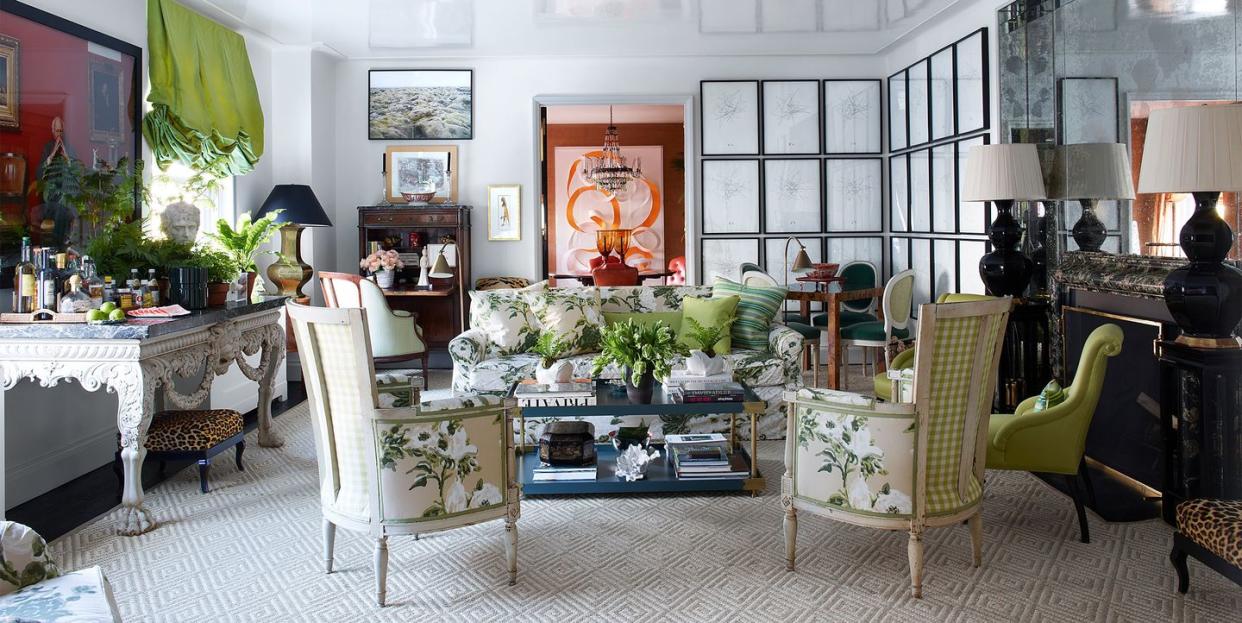How One Woman Integrated Years Of Design Inspiration In Her Home

- Oops!Something went wrong.Please try again later.
When Kate and Alexander Brodsky moved with their two young daughters from an 1,800-square-foot Upper East Side apartment to one nearby that was almost twice the size, Kate finally got to dig deep into her inspiration file. Actually, there were two files: the one containing tangible bits, like a swatch of Gracie wallpaper and a photo of a David Hicks floor, and the one that has existed in her head pretty much since she could walk.
Brodsky, owner of the brilliantly curated antiques and home- accessories boutique KRB and daughter of Los Angeles decorator Suzanne Rheinstein (who herself owns the celebrated shop Hollyhock), spent her youth tagging along to fabric showrooms with her mom and being dragged (mostly willingly) through some of the world's great houses and gardens. Her late father grew up just a few blocks from her new apartment, in a townhouse designed by Aymar Embury II, the influential New York architect of the 1930s and '40s.
As a child, Brodsky loved leafing through the photos of her dad's house; when she brought the tattered binder to her architects, Dick Bories and James Shearron, it turned out they were big fans of Embury's work. "Kate is so young, but she has such passion about things," says Shearron. "She completely gets all this curious, esoteric stuff. The way she made it come together was pretty amazing."
[embed_gallery gid=2508 type="simple"]
To begin with, the trio agreed that the space needed architectural tweaking. The library was given doors so that it now opens onto the commodious living room, which in turn opens onto the dining room. The French doors themselves were made as tall and lean as possible, says Shearron, in order to channel a Paris apartment. "It's incredible how much you can change the proportion of the whole space just by changing the size of the doors," says Brodsky. "And if you have a chance to create an enfilade, who passes that up?"
In the entrance hall, the ceiling, complete with modillions, was designed to hide beams and cumbersome electrical bundles, while the floor is a chic black and white–patterned limestone, with the bonus, says Brodsky, of being "moppable." The wall color, Farrow & Ball's Orangery, is such a favorite that it's made an appearance in three of her previous apartments, starting when she was in college.
But elsewhere, with few exceptions (including the blue master bedroom that was a request from her husband), the dominant shade is green. "I grew up in L.A. with a lush backyard garden," says Brodsky. "That's what I missed most when I got to New York." The living room's verdant Bob Collins & Sons chintz (a swatch of which she'd kept tucked away for "at least five years") created an indoor garden of sorts and is, she insists, surprisingly practical. "I like things that are dressy but also comfortable and livable, and to me, chintz is eminently livable. It's forgiving of dogs, kids, feet, wine, life."
[embed_gallery gid=2508 type="simple"]
The bright olive-lacquered library features a foliage-inspired carpet by Colefax and Fowler and brass-embellished shelves à la Brooke Astor's famous library. "Everyone needs a nod to Albert Hadley," Brodsky says. The living room's bolection mantel is in yet another green, albeit not one found in any natural stone. Instead, Bories and Shearron commissioned a scagliola version that Brodsky refers to, delightedly, as "fantasy marble."
The dining room is papered in that dog-eared Gracie swatch, but minus the hand-painted flora and fauna the firm is known for. Brodsky used only the tobacco background color, and it's the kind of intuitive touch that marks the space. "We're on Lexington [Avenue]," she says. "This is not a Fifth Avenue apartment. We didn't want to try and make it grander than it is—there are no foot-and-a-half baseboards." Indeed, in the living room, the team left the almost imperceptible cove moldings and launched a search for unobtrusive doorknobs. "Kate understood that things do not have to be big just to be big," says Shearron. "It sounds snobbish, but it's the subtlety of taste."
Though the Brodskys bought new things for the apartment, its layered look comes from the fact that many pieces have been with them both for years. Alexander, a partner in his family's real estate firm, began collecting photographs in college; a tiger-velvet slipper chair was a long-ago birthday present from Kate's mother. "We definitely didn't get rid of anything," she says.
[embed_gallery gid=2508 type="simple"]
While one of the narratives Brodsky concocted to drive the decor included "imagining what David Adler would have done to a Manhattan apartment," the goal was creating a home for an active family. "It was about finding a balance," Kate says, "between a little bit of New York glamour and a place that can handle seven children building tepees." That challenge was made easier by giving the girls the lavish space that would ordinarily do duty as the master bedroom. But it was worth it for a bit of glamour: "We can have 75 for cocktails, and the girls can still go to bed at 7:15 and not hear a thing."
You Might Also Like

